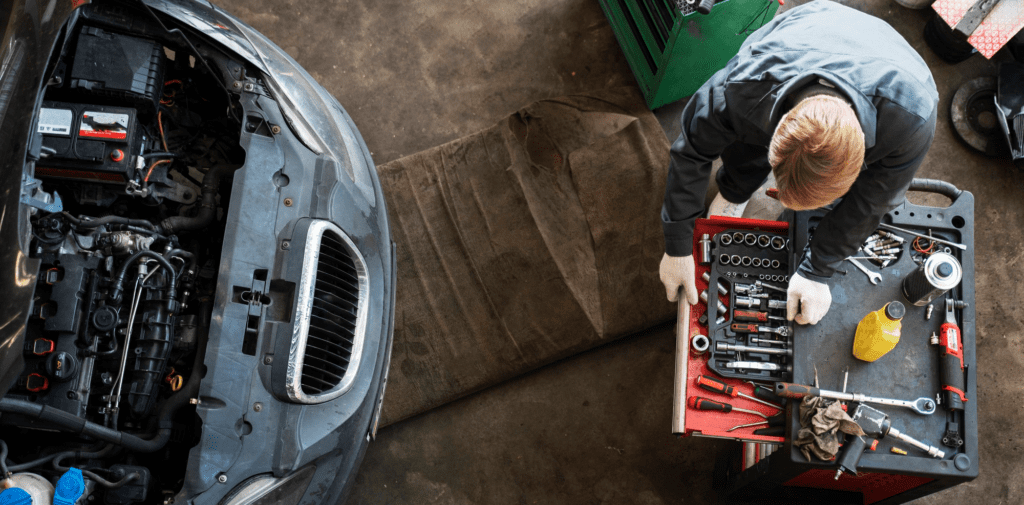Compare cheap car insurance
✔ Compare cheap car insurance quotes
✔ Over 110 insurance providers
✔ Get a quote in minutes
✔ Save up to £504*


When considering purchasing or selling a car, its service history can significantly determine its value. This history provides insights into the vehicle’s upkeep over time.
- What is a car service history?
- What is included in a car service?
- Why is a car service history so important?
- What does full-service history mean?
- What does part service history mean?
- How to find a car’s service history
- Frequently asked questions
Follow these steps to uncover the full-service background of a car and gain insights into its previous care.
What is a car service history?
Think of a car’s service history as its health diary. It’s akin to a person’s medical history, meticulously detailing all the services, upkeep, and repairs it has undergone throughout its life.
A comprehensive service history should encompass:
Routine Maintenance
Regularly scheduled activities such as oil changes, air filter replacements, and wheel balancing and rotation are pivotal to maintaining the vehicle’s optimal performance.
Service Book
Historically, every car came with a service book. Mechanics and garages would detail each annual service, noting the vehicle’s mileage and any other relevant activities. This record was validated with an official stamp to ensure authenticity.
Detailed Records
Apart from the service book, a thorough service history would also include itemised receipts and invoices. These documents give insights into repair work undertaken and their associated costs, offering a clear picture of which parts have been replaced and the dates they were attended to.
Digital Transition
With technological advancements, the traditional paper service book is gradually being replaced. Many contemporary cars now come with a digital service log. In line with the digitisation trend, garages have pivoted towards maintaining online service records.
Manufacturer Records
When a vehicle is serviced at a franchised dealer, the car manufacturer typically maintains centralised online records. This initiative ensures that you can effortlessly access, review, and authenticate your vehicle’s service history whenever necessary.
For those eyeing a pre-owned vehicle, mentioning the car’s service history is common in the listing. Here’s a brief breakdown:
FSH (Full Service History): Indicates that the car has a complete and detailed service record.
PSH (Part Service History): Points out that some service records might be absent or incomplete.
By delving into a car’s service history, potential buyers can gauge the vehicle’s overall condition, making it an indispensable tool for informed decision-making.
How much can you save on your car insurance?
What is included in a car service?
A car service is comparable to a comprehensive medical check-up but for your vehicle.
This procedure, performed by a skilled mechanic, evaluates the overall health of your car, addressing wear and tear, and rectifying issues by replacing or repairing necessary parts.


While the frequency might vary based on your car’s model, usage, and other factors, it’s typically advised to get a full car service every 12 months or every 12,000 miles—whichever milestone you reach first.
Here’s an expanded look at what a standard car service entails:
Engine Maintenance
This involves inspecting the engine for any irregularities, changing the oil, and replacing the oil filter to ensure optimal performance.
Fuel System
For diesel vehicles, the fuel filter requires replacement to maintain efficient fuel combustion and protect the engine from contaminants.
Body Examination
The car’s bodywork is scrutinised for dents, scratches, rust, or any other signs of damage that might affect its appearance or structural integrity.
Lighting and Visibility
All lights—including headlights, tail lights, and indicators—are checked for functionality. Additionally, wipers and windscreen conditions are examined to ensure clear visibility.
Tyres and Exhaust
Tyres are inspected for wear, punctures, and correct pressure, while the exhaust system is evaluated for leaks and efficient operation.
Braking and Steering Systems
Brakes are pivotal for safety, so their components, like pads and fluids, are checked. The steering system, ensuring smooth manoeuvring, is also assessed.
Fluid Levels and Cooling System
From brake fluid to windshield washer, all fluid levels are topped up. The cooling system, which prevents engine overheating, is inspected, and air-conditioning systems might be re-gassed if needed.
Suspension
This check ensures a smooth ride, evaluating shocks, struts, and other related components.
Battery Health
The car battery’s life and output are analysed to confirm reliable starts and consistent power supply.
Wheel Care
Ensuring stability on roads, wheel alignment, balancing, and rotation are all inspected to prevent uneven tyre wear and ensure optimal vehicle handling.
Electrical Components
For the growing fleet of hybrid and electric cars, special attention is given to charging ports, cables, and connections, ensuring efficient charging and energy transfer.
It’s worth noting that while these are standard checks, specific models or types of vehicles might require additional specialised attention.
Always refer to your car’s manual or consult with your mechanic to ensure you’re getting the most appropriate service for your vehicle.
How much can you save on your car insurance?
Why is a car service history so important?
A car service history isn’t just a logbook; it’s a testament to the vehicle’s health and history.


Regularly servicing your vehicle offers multiple benefits that extend beyond mere upkeep:
Longevity and Cost-Savings: Regular services extend your car’s life, ensuring optimal performance for longer periods. Addressing minor issues during these checks prevents them from becoming expensive and extensive repairs later on.
Enhanced Resale Value: For sellers, a comprehensive service history demonstrates to potential buyers that the car has been diligently maintained. It often becomes a major selling point, potentially boosting the vehicle’s resale value.
Buyer’s Confidence: For buyers, a detailed service history offers reassurance about the car’s condition, highlighting any persistent issues or past repairs. It’s a crucial tool for informed decision-making, reducing the risk of investing in a problematic vehicle.
Insight into the Car’s Backbone – Chassis Servicing: Delving deep, the servicing of a car’s chassis – its underlying framework – is vital. Regular checks ensure structural integrity, a significant factor influencing a car’s safety and performance.
Insurance Implications: A consistent service record could be beneficial when dealing with insurance claims. If your car gets damaged beyond repair, insurance companies might use the service history to determine its pre-accident value, influencing your claim’s outcome.
Ownership and Documentation: While the V5C log book registers the vehicle’s keeper, it doesn’t always indicate ownership. Complementary documents like sales receipts further solidify proof of ownership, offering a clear distinction between the registered keeper and the actual owner.
Informed Purchase: When considering a pre-owned vehicle, equipping oneself with as much information as possible is crucial. Checklists, like our recommended one for buying used cars, can guide buyers in ensuring they make a wise investment.
In essence, a car’s service history is more than just a record; it’s a reflection of its journey over the years. Whether you’re buying, selling, or simply maintaining your vehicle, this history remains an indispensable asset.
How much can you save on your car insurance?
What does full-service history mean?
The term “Full Service History” (FSH) serves as a car’s detailed medical record, ensuring potential buyers or the current owner of the vehicle’s regular upkeep and good health.
Here’s a breakdown of what FSH entails and why it’s pivotal:
Complete Records: When a car boasts an FSH, it means there’s a comprehensive record of every annual service the vehicle has undergone. This record doesn’t just highlight regular maintenance intervals but also offers a deep dive into specific tasks performed, from routine procedures like fluid top-ups and tyre replacements to more extensive repair works.
Documentary Evidence: While not a strict requirement, the presence of receipts and invoices for services and repairs is a strong testament to the car’s diligent upkeep. These documents can provide invaluable insights into the vehicle’s care regimen and the quality of work done.
Authorised Service Centres: An FSH often indicates that the car has been frequently serviced at official garages or service centres endorsed by the car’s manufacturer. Such centres often follow the best practices, ensuring the car receives the care and parts it’s specifically designed to work with.
Enhanced Resale Value: A well-maintained vehicle with an FSH is likely to command a higher price in the resale market. It’s proof of the vehicle’s good health, which reduces uncertainties for potential buyers, making them willing to pay a premium for reliability.
Reduced Maintenance Costs: An FSH often correlates with fewer unexpected breakdowns and exorbitant repairs. Regular, systematic maintenance can pre-empt major issues, ensuring the car runs smoothly and is less prone to unforeseen mechanical failures.
Warranty Benefits: For cars still under warranty, an FSH can be crucial. Most manufacturers mandate regular servicing at approved centres as a condition for upholding the warranty. In the event of a malfunction, manufacturers might refer to the service history before agreeing to a warranty-covered repair. Without a full-service history, there’s a risk that warranty claims might be declined.
“Full-Service History” isn’t just a term; it’s a validation of a car’s meticulous care and upkeep. It provides both current owners and potential buyers with an assurance of the vehicle’s condition and reliability.
How much can you save on your car insurance?
What does part service history mean?
“Part Service History” (PSH) is a term encountered frequently in the automotive world, particularly in the context of used vehicles.
It essentially indicates that a car’s service records are incomplete. Let’s delve deeper into what this means:
Service Gaps and Non-approved Garages: A car that has skipped a scheduled service or has been serviced by a non-approved or unauthorised garage typically falls under the PSH category.
Incomplete Documentation: When purchasing a used car, it’s paramount to request its service history. A PSH implies that there might be gaps in the service record, either because some documents are missing or due to inconsistent servicing.
Reasons for PSH: While a PSH can raise eyebrows, it doesn’t invariably suggest an issue with the vehicle’s condition. Various scenarios can lead to a PSH. For instance, a car owner might misplace service receipts, or there could have been oversights at the garage where they forgot to record a service.
Negotiation Leverage: A car’s service history significantly influences its perceived value. As a potential buyer, a PSH can serve as a negotiation point, possibly enabling you to get a better deal because of the uncertainty it introduces. On the flip side, if you’re selling a car with a PSH, you might have to settle for a lower price compared to if you had a full-service history.
Risk and Due Diligence: Although a PSH doesn’t definitively signal a problematic car, it does mean prospective buyers should be more cautious. Consider getting a thorough mechanical inspection by a trusted mechanic to unearth any potential issues. Such a step provides peace of mind and helps ascertain the car’s actual condition.
Impact on Warranty and Insurance: Cars with a PSH might face challenges if they’re still under warranty, as certain manufacturers might require a full-service history for cover. Additionally, some insurance providers might view a PSH as a higher risk, potentially affecting premiums.
While “Part Service History” adds a layer of complexity when buying or selling a car, it shouldn’t be an automatic deal-breaker.
It’s a prompt for more investigation and potentially a tool for negotiation. Knowledge and due diligence are key when dealing with vehicles that come with a PSH.
How much can you save on your car insurance?
How to find a car’s service history
Finding out a car’s complete service history can be an enlightening experience, offering insight into its past upkeep and any potential issues.


If you’ve misplaced the service book or are considering buying a used car, there are several avenues to explore:
Contact the service centre or manufacturer
Lost Service Book: If you can’t locate your service book, your immediate point of reference should be the service centre where your car typically undergoes its yearly inspections. They’re bound to have a repository of your car’s past services and related maintenance work.
Dealership and Digital Records: Modern cars serviced by authorised dealerships often have their maintenance records stored digitally. You can approach the dealership or even the car manufacturer’s online portal for this data. On the other hand, if your vehicle was attended to by an independent mechanic, tracing its digital service footprint may be challenging, especially for older models. Regardless, initiating your quest here is advisable.
Ownership Verification: Before accessing this data, establishments will require proof that you are the legitimate owner. Essential documents typically include the purchase receipt and the VIN. If you’re pondering purchasing a vehicle, the existing owner’s consent might be crucial due to data protection regulations.
Ask the DVLA
If you’re the legal owner of the vehicle, the Driver and Vehicle Licensing Agency (DVLA) could be a goldmine of information. This agency can provide insights into past ownership and service providers.
To procure this information, you’ll need to submit the V888 form, accompanied by a £5 cheque or postal order.
The DVLA’s service can be used only for vehicles you own or have previously owned. Prospective purchases are excluded from this service.
Check MOT service history
The DVLA website is a reliable source for the MOT service history, covering records for tests conducted in England, Scotland, and Wales since 2005.
This service provides comprehensive details on the nature of each MOT, issues discovered, and any components that either failed the test or were earmarked as minor concerns.
Basic requirements include the vehicle’s registration number, and for a detailed MOT venue list, the 11-digit number from your V5C logbook will be necessary.
Furthermore, if the MOT was executed by an authorised dealer, they would likely possess the complete service records.
Get a vehicle history check
For those considering the purchase of a used vehicle, an extensive vehicle history check is invaluable, even with a furnished full-service history.
Reputable car bodies provide detailed insights into a car’s history, encapsulating:
- If the car’s been reported stolen
- If there’s outstanding finance on the car
- If it’s had its mileage altered
- If it’s an insurance write-off
- V5C/VIN match
- Number of previous owners
These vehicle history evaluations are relatively affordable and are instrumental in ensuring the car you’re considering doesn’t have lurking issues and that your transaction is transparent.
How much can you save on your car insurance?
Frequently asked questions
To confirm that a car’s service history is genuine, you should cross-reference the entries in the car’s service book. Every service should be endorsed with a stamp from the respective service centre.
It’s advisable to make calls to these service centres to corroborate that they performed the services as indicated.
For newer vehicles that have been maintained at authorized service centres, the car manufacturer typically retains a record of the service history.
Typically, many car manufacturers advise having a comprehensive service either annually or every 12,000 miles, depending on which milestone is reached first.
Modern vehicles might be equipped with an automatic reminder to prompt you when a service is required. If your car lacks this feature, you can refer to your logbook to determine the due date for your upcoming service.
FDSH is an abbreviation for full dealer service history, occasionally denoted as main dealer service history (MDSH). This signifies that every service the car has undergone was executed by a dealer authorised by the car’s manufacturer.
Such authorised dealers adhere to using parts endorsed by the manufacturer and employ technicians specifically trained for that particular brand.
A notable advantage is that this makes the vehicle’s service records straightforward to access and validate.
Yes, a car that lacks a full-service record or has an incomplete one will typically hold a lower value compared to its counterpart with a comprehensive service history.
The absence of a complete history introduces an element of uncertainty. Prospective buyers examining a car with a PSH should be diligent in their research and advocate for a price adjustment that compensates for this ambiguity.
Often, this can result in a reduction of around 10%-20% from the initial price.
Modern cars are equipped with a service or maintenance manual, typically stowed in the glove box.
This manual features several pages intended for record-keeping, capturing specifics like the nature of the service, mileage at the time of service, service date, and the stamp from the service provider.
Yet, with the shift to digital service documentation in many garages, these traditional service booklets are often left untouched and unstamped.










